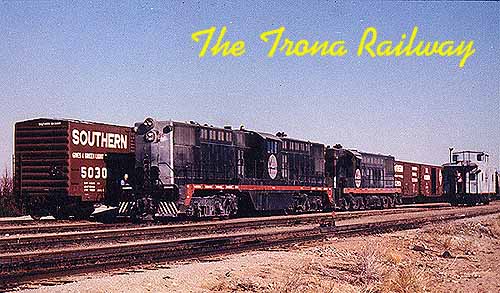| by BRUCE PETTY
|
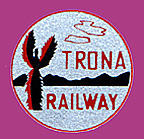 |
The summer of 1972, I visited the Trona Railway to photograph the Baldwin Diesel Locomotives. These were the last of their kind, with a diesel engine that sounded like it was going to self destruct any second, leaving it's pistons and parts along the right-of-way.
NEW! Here's a Trona Railway, HO layout in PDF format (888.5KB),
I had designed for the 2006 layout contest for Model Railroader Magazine.
It didn't win, but this shelf layout can be expanded to whatever room size you may have.
|
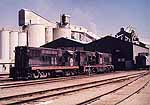 | The Kerr-Mcgee Chemical Company as seen in the background is where the Potash is processed. The Baldwins were serviced in the engine house at night when it was much cooler. One of the diesel mechanics gave a tour of this building, showing a broken piston that had been removed. No wonder the pistons sound like they're going through the roof. |
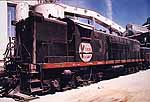 | This old Baldwin Diesel AS-616, once belong to the Southern Pacific. This was the Baldwin Locomotive Works answer to diesel motive power after the end of steam locomotive manufacturing. |
 | The Trona Caboose. No A.C. in this one. |
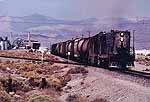 | You can hear them, before you see them, as a loaded train of phosphates heads to Searles, the interchange with the Southern Pacific thirty six miles from the Kerr-McGee Plant in the background.
|
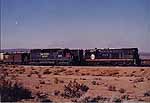 | As the Trona Railway pulls into Searles to drop its train of loaded potash cars, the westbound Lone Pine Local pauses for a few minutes while on its way back to Mojave. This is the "Jawbone Branch" of the Southern Pacific and is run as train order territory from Mojave to Lone Pine. |
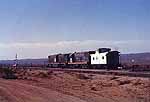 | After dropping off there cars at Searles, it's a caboose hop back to the plant. Later the Southern Pacific's "Trona Turn" train will be arriving from Taylor Yard to drop off empties and pick up loads. The crew was on duty at 7:00AM at Taylor Yard, will eat and rest at Searles for eight hours before heading back to Los Angeles. As one S P crew member said about switching cars after dark at Searles, "It's the coldest place I've ever worked!". |
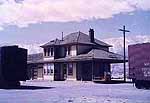 | The Lone Pine Station is the eastward end of the 193.3 mile "Jawbone" branch. The Lone Pine Local would work out of Mojave, Mon-Wed-Fri. east to Lone Pine, and Tues-Thur-Sat. west to Mojave. No work Sunday. |
| Freight Cars Used To Move Potash Photos of Standard and Cylindrical Hoppers taken in the 1960s.
The Atlas Model Company has produced the Cylindrical Hopper car with the Trona logo with two car numbers. Here is a picture on their model Atlas Trona Cylindrical Hopper , so email the Atlas Model Company hoscale@atlasrr.com and thank them for producing the Trona cars. Model companies really like hearing form happy customers.
If you would like more information about Trona Railway or the Potash Plant at Trona, see;
|








